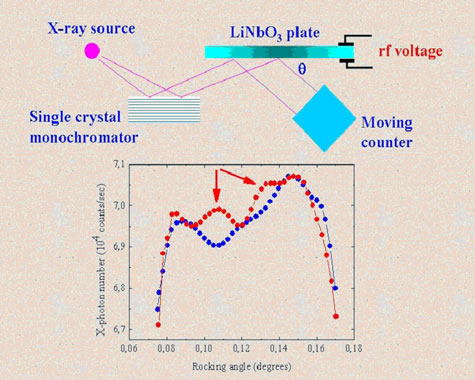Igor Ostrovskii - iostrov@phy.olemiss.edu
Univ. of Mississippi
Dept. of Physics and Astronomy
University, MS 38677
M. Borovoy
O. Korotchenkov
Andrij B. Nadtochii
R. Chupryna
Kiev Shevchenko University
Physics Department
Kiev 02022, Ukraine
Popular version of paper 2aPA7
Presented Tuesday Morning, May 25, 2004
147th ASA Meeting, New York, NY
Ferroelectric crystals and thin films like lithium niobate (LiNbO3) find extensive range of applications in telecommunications and information technologies, electro- and acousto-optic devices. These include cellular phones, memory and electro-optical switching elements, complex structures for photonic bandgap devices, thin film capacitors, sensors, etc. The asymmetric arrangement of the positive and negative ions in the unit cell of LiNbO3 imparts permanent electric dipole behavior to the crystals. Groups of unit cells with the same polarization and deformation orientation are called domains. For improving performance of the devices based on ferroelectric crystals, it is essential to fully understand and to control the ferroelectric domains, featuring the properties of these materials. Recently much attention in the science community has been devoted to so-called domain manipulation (or "engineering"), i.e., a fabrication of customized domain structures. Here, we report a new way of achieving this goal with the help of ultrasound.
Due to electrical and mechanical anisotropy, these types of materials exhibit spontaneous polarization and deformation. During the poling process, an intense electric field (> 104 V/cm) is applied to the crystals. With the field applied, the material expands along the axis of the field, i.e., along the axis the domains line up, and contracts in the direction perpendicular to that axis. When external electric field is removed, the internal electric dipoles stay roughly, but not completely, in alignment. The material now has a permanent polarization. Materials that can be polarized by applying an electric field (or a mechanical stress) are named piezoelectric materials, and the class of the piezoelectric materials includes ferroelectrics. When a voltage is applied to the poled piezoelectric material, the ions in the unit cells are shifted and, additionally, the domains change their degree of alignment.
In practice, the radiofrequency voltage can be applied to stripe metal electrodes formed at one edge of the piezoelectric plate allowing the sound wave to be launched in the plate due to reverse piezoelectric effect. The traversed wave can be detected in a similar manner, by forming the electrodes on the other edge of the plate. While traveling across the crystalline plate, the ultrasonic wave influences the orientation of the ferroelectric domains due to accompanying strain and electric fields.
We believe that both the manipulation and the imaging of ferroelectric domains
can be performed with above discussed technique. One example is presented here.
 |
| X-ray experiment schematics and rocking curves taken without (blue) and with (red) sound wave traveling in the LiNbO3 plate. Mechanical strain in the wave is about 5x10-5. Arrows indicate the shape change due to reoriented domains. |
The shape of the initial curve (blue) is rather sensitive to the sound wave traveling in the plate (red) and can easily be related to the domain reorientation processes. The occurrence of these processes is also supported by chemical etching experiments, which reveal domain boundaries on the surface of the plate affected by ultrasound.
From these and other results obtained, a better understanding of the domain
dynamics is gained. The non-destructive domain imaging method utilizing ultrasound
is furthermore envisaged. For example, by using a scanning force microscope,
the ultrasonically manipulated domains can be imaged on a sub-micron resolution
scale.